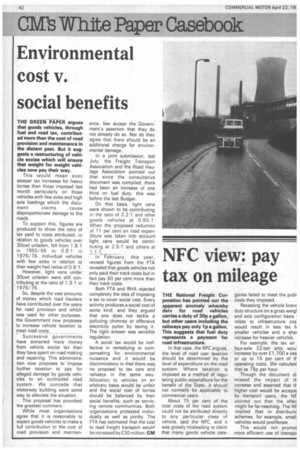Environmental cost v.
Page 44

If you've noticed an error in this article please click here to report it so we can fix it.
social benefits
THE GREEN PAPER argues that goods vehicles, through fuel and road tax, contributed More than the cost of road provision and maintenance in the distant past. But it suggests a restructuring of vehicle excise which will ensure that weight for weight vehicles now pay their way.
This would mean even steeper tax increases for heavy lorries than those imposed last month particularly on those vehicles with few axles and high axle loadings which the docu ment claims cause disproportionate damage to the roads.
To support this, figures are produced to show the ratio of tax paid to costs attributed, in relation to goods vehicles over 30cwt unladen, fell from 1.8:1'
in 1965/66 to 0 8 1 in 1975/76. Individual vehicles with few axles in relation to their weight had ratios of 0.6:1.
However, light vans under 30cwt unladen were still contributing at the ratio of 1.9:1 in 1975/76.
So, despite the vast amounts of money which road hauliers have contributed over the years for road provision and which was used for other purposes: the Government now proposes to increase vehicle taxation to meet road costs.
Successive governments have extracted more money from vehicle excise tax than they have spent on road making and repairing. This administration now proposes to impose further taxation to pay for alleged damage by goods vehicles to an outmoded road system. We concede that motorway building went some way to alleviate the situation.
This proposal has provoked the greatest comment.
While most organisations agree that it is reasonable to expect goods vehicles to make a full contribution to the cost of road provision and mainten ance, few accept the Government's assertion that they do not already do so. Nor do they agree that there should be an additional charge for environmental damage.
In a joint submission, last July, the Freight Transport Association and the Road Haulage Association pointed out that since the consultative document was compiled, there had been an increase of one third on fuel duty; this was before the last Budget.
On that basis, light vans were shown to be contributing in the ratio of 2 2:1 and other goods vehicles at 0.95:1. When the proposed reduction of 11 per cent on road expenditure was taken into account light vans would be contributing at 2.5:1 and others at 1.1:1.
In February, this year, revised figures from the FTA revealed that goods vehicles not only paid their track costs but in fact pay 50 per cent more than their track -costs.
Both FTA and RHA rejected completely the idea of imposing a tax to cover social cost. Every activity produces a social cost of some kind, and they argued that one does not tackle a polluting chimney or offensive electricity pylon by taxing it. The right answer was sensible regulation.
A social tax would be ineffective in remedying or compensating for environmental nuisance and it would be discriminatory in that there was no proposal to tax cars and railways in the same way. Allocation to vehicles on an arbitrary basis would be unfair and the social cost of lorries should be balanced by their social benefits, such as servicing remote communities. Both organisations protested individually as well as jointly. The FTA has estimated that the cost to road freight transport would be increased by E30 million. CM




















































































